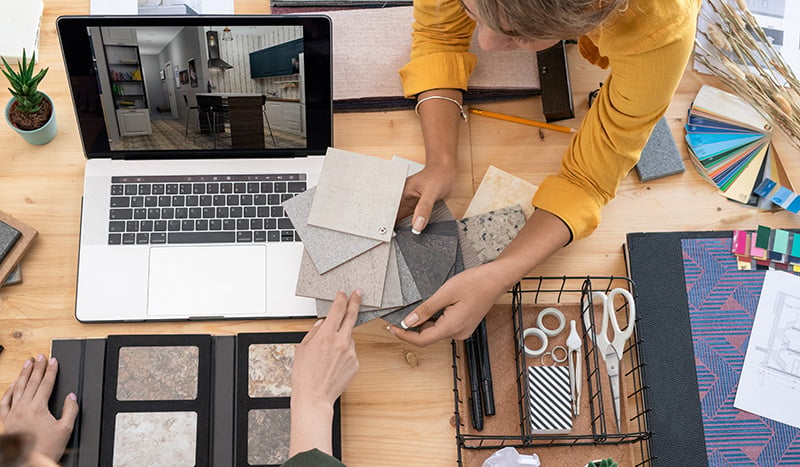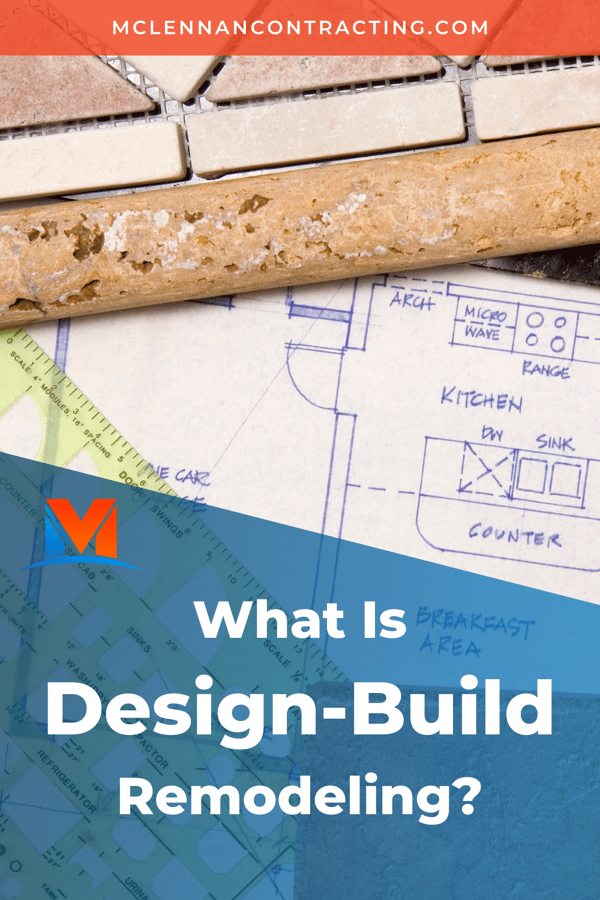10 min read
What Is Design-Build Remodeling? (And Why It Matters for Your Lancaster Home)
By: Alison McLennan | September 7, 2022

Research shows that Design-Build out-performs other project delivery methods in cost, schedule, and delivery speed. It can work with construction projects of all sizes, from large-scale commercial renovations, to custom homes, to single-room kitchen remodels.
But what, exactly, is Design-Build remodeling, and how might it affect your Lancaster home remodel?
What Does “Design” Mean in Remodeling?
Before we dig into the Design-Build method, it’s important to clarify what is meant by the term “Design.”
There is often confusion around this word, because it can bring to mind purely aesthetic functions, like interior decorating. However, in remodeling, “Design” means planning the structural, mechanical, and cosmetic elements of each project in order to produce the desired outcome for the client.
“Design” means planning the structural, mechanical, and cosmetic elements of each project in order to produce the desired outcome for the client.
Just a few of the activities included in Design are:
- Conducting feasibility studies
- Determining mechanical specifications
- Analyzing code requirements
- Creating 3D renderings
- Selecting products and finishes
Making a project beautiful is also part of the design process, but in a sense it is really icing on the cake. Design generates an in-depth understanding of a project’s functional requirements, which is necessary to ensure the finished product can be enjoyed for years to come.
Does Every Remodeling Project Need Design?
Because of misconceptions about design, homeowners sometimes assume their remodel is too small or straightforward to need it.
But design is essentially a decision-making process that facilitates a project being constructed correctly and in a way that meets the clients’ needs and expectations. For that reason, no remodel is too small for project design.
The design requirements for some projects might be minimal, but there is always an element of design needed to effectively plan any home remodel.

How Is Design-Build Different than Traditional Remodeling?
Design is a key differentiator between Design-Build remodeling and traditional remodeling (a.k.a. the Design-Bid-Build method). While both of these project delivery methods include design, they differ in how, when, and where that design happens.
Traditional Remodeling = Segmented Design
In traditional remodeling, a project’s design is usually handled in one of three ways:
- Homeowner Design: The homeowner has a vision for their project, and creates their own design, possibly using an online program or simply sketching on paper. The degree of design detail varies depending on the knowledge of the homeowner.
- Independent Design: The homeowner works with an independent designer or architect to create drawings and/or renderings for their remodeling project. The degree of design detail varies depending on the type of designer or architect.
- Contractor Design: The homeowner requests an estimate from a contractor based on a general concept. The contractor provides a price based on assumptions and/or allowances, leaving the detailed design work to be completed after a construction contract is already signed.
Design-Build Remodeling = Integrated Design
In contrast to traditional remodeling, Design-Build remodeling incorporates all aspects of a remodel—from preliminary design to finished production—into one streamlined process.
In other words, rather than working with an independent designer or architect, the homeowner works with a Design-Build company to clarify their needs and wants, create a functional design, make product selections, and flesh out all detailed specifications for the project.
The project’s budget is built throughout the design process. This allows the homeowner to play a collaborative role in determining their financial investment, and to feel confident in a fixed price before committing to a construction contract.
Design-Build remodeling incorporates all aspects of a remodel—from preliminary design to finished production—into one streamlined process.
What are the Pros and Cons of Choosing a Design-Build Company?
Despite its many strengths, Design-Build isn't necessarily the right remodeling approach for everyone. It's important to consider the pros and cons, and ask yourself if you're on board with the Design-Build process.
Pros of Choosing a Design-Build Remodeler
1. Reduced Stress for the Homeowner
In traditional remodeling, the homeowner may be forced to juggle multiple contracts or play the role of project manager. Coordinating communication and schedules between parties can be a full-time job and add significant stress to the remodeling process.
Design-Build simplifies the homeowner’s role by providing a “one-stop shop” for all of their project needs. Design-Build is collaborative and client-focused, so the homeowner retains control of decisions but is able to pass off the burden of project management to their contractor.
A good Design-Build company will have a clearly defined process to guide clients through decision-making. Being able to follow a proven, step-by-step plan lowers stress for the client and reduces decision fatigue.
2. Excellence through Collaboration and Teamwork
When a homeowner works with a Design-Build company, they have a team of remodeling specialists invested in their project. Designers, project managers, carpenters…these are experts in their field who have successfully completed many projects together.
Combining the team’s knowledge, skill, and creativity with the homeowner’s unique vision leads to beautiful, high-satisfaction remodeling projects.
3. Faster, Smoother Production Phase
Design-Build involves a thorough design phase, followed by intensive, internal pre-production planning.
At McLennan, designers and carpenters thoroughly review and discuss scopes of work, special-order product specifications, mechanical locations, and specifics needs of the homeowners. During pre-production, our team orders and inspects materials, schedules and confirms trade partners, and plans for every detail, down to where our field crew will park their vehicles.
We do all this planning to make sure a project is produced as efficiently and smoothly as possible. Efficient production leads to happy clients and healthy companies, so it’s a win for all involved.
When a homeowner works with a Design-Build company, they have a team of remodeling specialists invested in their project.

Cons of Choosing a Design-Build Remodeler
1. Requires Trust in Your Contractor
Any downsides of Design-Build really come down to one core issue: TRUST.
To enter the Design-Build process, the homeowner must feel comfortable making a financial investment in design, prior to receiving a custom estimate or fixed quote for their project.
In areas like Lancaster, where Design-Build is less common than traditional remodeling, this can seem like a big ask. Why should you pay a Design-Build company to develop a design and budget for your project, when other contractors are offering free quotes?
It’s a valid question, and really comes down to what you believe about free quotes, and whether they actually benefit you. To consider that, let's look at competitive bidding in the context of Design-Build's other con.
2. Initial Estimates Might Seem Higher than Traditional Remodeling
In Design-Build, since design and production are happening under one roof, there is no competitive bidding between multiple contractors.
Traditional remodeling’s bidding process pressures contractors to undercut one another on initial estimates in order to win the job. This creates overly optimistic pricing, most often based on assumptions rather than specifications. Not surprisingly, any initial savings for the homeowner usually reverse by the end of the project in the form of costly change orders.
By contrast, a reputable Design-Build contractor will present a realistic initial investment range—not a competitive bid—and then develop a custom budget based on real client decisions during design.
While initial pricing might seem higher in Design-Build, the ending cost of the project is often less. This is because the depth of up-front planning in Design-Build drastically reduces the likelihood of significant change orders during construction.
While initial pricing might seem higher in Design-Build, the ending cost of the project is often less.
How to Find a Trustworthy Design-Build Contractor in Lancaster
So, you’ve weighed the pros and cons of the Design-Build method, and you're seriously considering it for your home remodel. What’s next? How do you find a contractor you can trust?
1. Choose a Project Delivery Method
Limiting your options to Lancaster Design-Build contractors is a big first step. The majority of Lancaster remodelers follow the traditional remodeling method, so choosing Design-Build will automatically narrow your search to some of Lancaster's best remodeling companies.
If you have acquaintances who have recently had a great remodeling experience, ask them who they used. There’s a good chance their answer will be one of the companies on your list.
2. Research Your Short List
Once you have your short list of reputable Design-Build remodelers, you can hone in further by reading online reviews and checking out their websites.
Look for signs that their expertise has deep roots:
- Do they have a good reputation across multiple online platforms, such as Google, Houzz, and independent surveyors like GuildQuality?
- Do they have a professional portfolio of completed projects?
- Does their website provide helpful content that demonstrates experience and knowledge relevant to your project?
- Have they been formally recognized for excellence by their community or professional organizations?
3. Have a Compatibility Check
Once you’ve established which Design-Build companies meet these criteria, it’s time to schedule a consultation to get a feel for whether your project and their company might be a good fit.
There are plenty of great Design-Build companies out there, so it’s not always a question of making the “right” or “wrong” choice. In the end, it might come down to who you feel most comfortable with.
What kind of dynamic works best for you? How do you like to communicate? If you’re going to be working closely with a team of remodeling professionals, and inviting them into your home, compatibility will be a key component to success.
...It’s not always a question of making the “right” or “wrong” choice. In the end, it might come down to who you feel most comfortable with.
If you think Design-Build might be a fit for you and your remodel, we'd love to come alongside you to help clarify your next steps. Our free consultations provide an opportunity to discuss your remodeling questions without hassle or obligation. Click below to schedule with one of our Project Consultants today.





